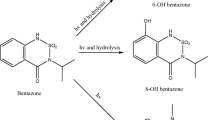Abstract
The radioactivity on adding 14C-Hexachlorocyclopentadiene (Hex) to water (7 7gmg/L) decreased by 18% on Day 2 and by 31 to 55% by Day 42. On Day 42, the radioactivity remaining in water consisted of apolar (petroleum ether-extractable), polar (ethyl acetate-extractable), and hydrophilic hydrolysis products with Hex amounting to only 8% of the total radioactivity. The time for Hex to reach 50, 10, and 5% of its initial concentration was estimated to be about 4, 27, and 40 days, respectively. The hydrolysis rate constant compared to 4×103 hr−1 as reported in literature. The apolar radioactivity (25% of total) consisted of Hex and a major product as judged by gas chromatography (GC). The polar products resolved into 10 and hydrophilics into 14 different compounds as examined by thinlayer chromatography.
The photolysis of Hex in acetone occurred very rapidly (t1/2=<1 day) with no trace of Hex after 15 days. Most of these products were more polar than Hex as examined by GC. These products on thin-layer chromatography (TLC) separated into two major zones. Further TLC of each of these zones showed products of one zone to resemble those of aqueous hydrolysis. The other zone represented apolar products which resolved into three peaks by HPLC, the major one of these appeared to have an empirical formula of C6Cl7O (m/e=408) as analyzed by GCMS.
The 8-h photolysis products' mixture had an LT50 to goldfish Carassius auratus of 22 h compared to 15 h for Hex. The 96-h LT50 value of the 15-day photolysis products' mixture was 2,300 compared with 119 μg/L for Hex. Thus, Hex in water as well as on exposure to light breaks down to less toxic products.
Similar content being viewed by others
References
Anonymous (1977) Chemical Hazard Information Profile. Hexachlorocyclopentadiene. TSCA Integratory Testing Committee, USEPA, Washington, DC
-- (1983) BMDP Statistical Software (Biomedical Program). WJ Dixon (ed) University of California, Berkeley, CA, p 734
Atallah YH, Whitacre DM, Butz RG (1981) Fate of hexachlorocyclopentadiene in the environment. In: Khan MAQ, Stanton RH (eds.) Toxicology of Halogenated Hydrocarbons. Pergamon Press, New York, pp 334–355
Butz RG, Yu CC, Atallah YH (1982) Photolysis of hexachlorocyclopentadiene in water. Ecotoxicol Environ. Safety 6:347–357
Chou A-FJ, Griffin RA, Chou M-IM, Larson RA (1987) Products of hexachlorocyclopentadiene (C-56) in aqueous solution. Environ Toxicol Chem 6:370–376
Johnston J (1972) Econometric Methods. McGraw Hill, NY
Larson RA (1983) Personal communication. University of Illinois at Urbana-Champaign, IL
Podowski AA (1989) Fate of hexachlorocyclopentadiene in water and goldfish. PhD dissertation. University of Illinois at Chicago, Chicago, IL, p 472
Podowski AA, Feroz M, Mertens P, Khan MAQ (1984) HPLC analysis of organochlorines using UV and radioactive flow detectors. Bull Environ Contam Toxicol 32:301–309
Podowski AA, Sclove SL, Pilipowicz A, Khan MAQ (1991) Biotransformation and disposition of hexachlorocyclopentadiene in fish. Arch Environ Contam Toxicol 20:488–496
Wolfe NL, Zepp RG, Schlotzhaner PF, Sink M (1982) Transformation pathways of hexachlorocyclopentadiene in water. Chemosphere 11:91–101
Yu CC, Atallah Y (1977) Photolysis of hexachlorocyclopentadiene. Velsicol Chem. Corp., Project No. 482428, Report No. 4, 4 pp
Zepp RG, Baughman GL, Schlotzhaner PF (1979) Dynamics of processes influencing the behavior of hexachlorocyclopentadiene in the aquatic environment. Paper presented at the Annual Meeting of Amer Chem Soc, Washington, DC
Author information
Authors and Affiliations
Rights and permissions
About this article
Cite this article
Podowski, A.A., Khan, M.A.Q. Hydrolysis and photolysis of hexachlorocyclopentadiene. Arch. Environ. Contam. Toxicol. 30, 21–29 (1996). https://doi.org/10.1007/BF00211325
Received:
Revised:
Issue Date:
DOI: https://doi.org/10.1007/BF00211325




